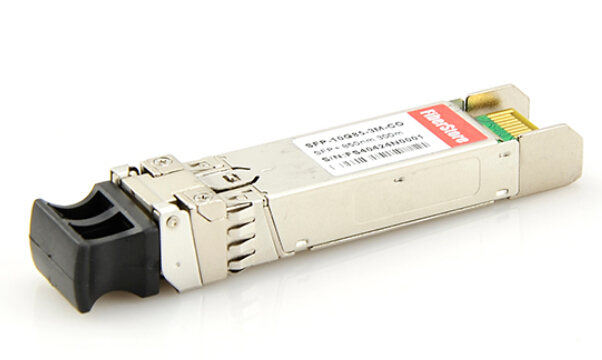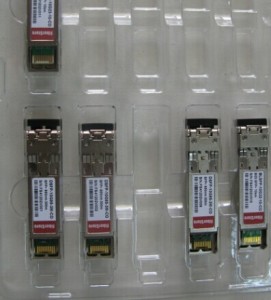Fiber Optics Solutions
srijeda, 03.06.2015.
How to Use DOM in Cisco System
Do you know that there is a fiber tester inside your optical transceiver? This "fiber tester" we call it DOM, which is short for Digital Optical Monitoring. DOM is a feature which enables the monitoring of some interesting status values on the interface with the most useful values being the optical receive and transmit powers. You can configure your Cisco (or other brand) device to monitor optical transceivers in the system, either globally or by specified port(s). When this feature is enabled, the system will monitor the temperature and signal power levels for the optical transceivers in the specified port(s). CONSOLE messages and SYSLOG messages are sent when optical operating conditions fall below or rise above the optical transceiver manufacturer’s recommended thresholds. By being able to monitor transmit and receive power levels of optical interfaces you are able to characterize the fiber loss and isolate any unidirectional connectivity issues. So, how to use DOM for your optical transceiver in Cisco system is our main topic today.
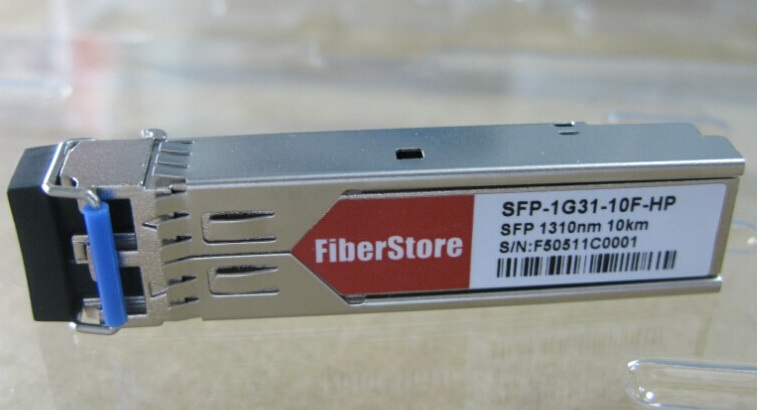
DOM allows to monitor some parameters so that network administrators can then check and ensure that the module is functioning correctly. These real-time operating parameters include:
- Optical Tx power
- Optcal Rx power
- Laser bias current
- Temparature
- Transceiver supply voltage
There are some restrictions of using DOM in Cisco system including:
- Ensure that your optical transceiver supports DOM. For Cisco original optical transceivers, you need the transceiver module compatibility information for configuring transceiver monitoring.
- In case of combo ports with SFP and RJ45 provision, when SFP is inserted in slot or port and media type is not configured to SFP, DOM is functional only if global transceiver monitoring is enabled.
- CISCO-ENTITY-SENSOR-MIB traps are sent only once after the threshold violation. However, SYSLOG traps are sent according to the monitoring interval.
| Command or Action | Purpose | |
| Step 1 | enableExample: Router> enable | Enables the privileged EXEC mode.• Enter your password if prompted. |
| Step 2 | configure terminalExample: Router# configure terminal | Enters the global configuration mode. |
| Step 3 | transceiver type allExample: Router(config)# transceiver type all | Enters the transceiver type configuration mode. |
| Step 4 | monitoringExample: Router(config-xcvr-type)# monitoring | Enables monitoring of all optical transceivers. |
| Step 5 | monitoring intervalExample: Router(config-xcvr-type)# monitoring interval 500 | (Optional) Specifies the time interval for monitoring optical transceivers. Valid range is 300 to 3600 seconds, and the default value is 600 seconds. |
In conclusion, there are three main command that can be used to turn on/off DOM for all transceivers type in the system:
- Router(config)#transceiver type all
- Router(config-xcvr-type)#monitoring
- Router(config-xcvr-type)#end
Once enabled, DOM can be accessed via CLI using "show interface transceiver command", shown as the following picture:

DOM is incredibly handy when troubleshooting fiber issues. A low value in the Rx Power column indicates that you have a bad fiber, or more commonly, a dirty fiber optic patch cable somewhere.
Of all the five values, two mostly used and relevant values are TX and RX power, and temperature is also used sometimes. The operating range of these three values is unique across all modules and is available in the data sheet. Additionally, there is an extension available for this command, which is also very helpful and is used to check threshold values of the above parameters like temperature, Tx and Rx. The command is "show interface gig x/y transceiver detail".
Though DOM is a very helpful functionality of optical transceiver, not all transceivers support DOM in Cisco's optical transceiver products family. For example, the common SFPs, such as the GLC-LX or GLC-SX units that are used by most network engineers on a day to day basis are not with DOM feature.
Why not add this helpful and convenient feature to all transceivers? Actually, Cisco have their own attitude. They think that DOM functionality is worth an extra $300 a pop, putting the cost of a DOM-enabled single mode SFP close to $800. However, DOM functionality is not a novel thing now. Surprisingly, there are some third-party optical transceiver include the DOM functionality but with a low cost. Fiberstore, for instance, as the professional optical transceiver manufacturer and supplier, they can offer Cisco compatible SFP transceivers with DDM or DOM functionality with a low cost. For example, GLC-LX-SM-RGD offered by Fiberstore just at $18.00, GLC-SX-MMD and GLC-LH-SMD at $10.00. But if we want to use non-Cisco transceivers, we need a little different approach to get started with DOM of non-Cisco transceivers. To enable support for non-Cisco SFPs, command "Router(config)#service unsupported-transceiver" is necessary.
Oznake: dom, Digital Optical Monitoring, optical transceiver, cisco
srijeda, 29.04.2015.
Muse on 10G SFP modules
As 10Gb SFP+ cables and transceivers have become more common in the current data centers, the issue of vendor lock or encryption might become a problem for data center technicians. This paper discusses the working principle which is used to implement the encryption, why it's employed and the way to overcome it.
2-wire Serial Interface
SFP+ cables and transceivers use a 2-wire serial interface (called I2C) so that the network equipment to poll a specific port and obtain specifics about the cable or transceiver that's connected to that port. This interface can also be known as the Digital Diagnostic Management Interface, Digital Diagnostic Monitoring Interface or DDMI.
The DDMI provides specifics about the cable or transceiver assembly including vendor, serial number, part number, and date of manufacture which is stored in a memory chip or microprocessor inside the cable assembly.
EEPROMs Information
SFP+ passive cables contain EEPROMs inside the connector back shell which have I2C ports. These cables can also be known as SFP+ DAC or SFP+ direct attached Twinax copper cables. An EEPROM is an "Electrically Erasable Programmable Read-Only Memory" chip which is programmed within the factory with precise information about the cable assembly.
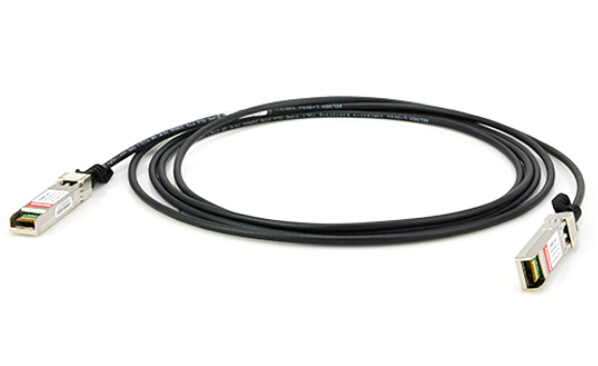
SFP+ active copper cables and fiber optic transceivers contain microprocessors inside the connector back shell. The microprocessor has memory which is available to the network through the 2-wire I2C interface. For active cables and transceivers, the interface allows real-time access to device operating parameters and includes alarm and warning signs, which alert the device when particular operating parameters are away from the factory settings.
Ordinarily, these EEPROMs and microprocessors abide by the SFF or Small Form Factor standards, which define the I2C interface protocol and allocate certain information to a particular memory location.
Vendor Lock and Encryption
Some vendors incorporate encryption or "vendor lock" inside their equipment that will issue an alert message if a non-vendor approved cable assembly is plugged into a port. In theory, this makes sure that devices manufacturers will not need to troubleshoot problems due to sub-standard cables. Oftentimes, devices vendors using encryption charge more for their own cords since they lock out use of other cords. In fact, encryption is unnecessary as all reputable manufacturers of SFP+ cables and transceivers meet the standards that IEEE and SFF have founded for SFP+ and interoperability isn't important. Most network equipment vendors that employ encryption allow a work around as long as the customer acknowledges the warning. As an example, the customer might have to acknowledge that he understands the warning and he can accept it before moving on.
Fiberstore’s Cisco Compatible SFP+ Cables Solution
Fiberstore is a professional OEM manufacturer and supplier of Cisco compatible SFP+ cables. Fiberstore has offered industry standard SFP+ cables for many years that have been tested by the UNH Interoperability lab and confirmed to be compatible with Cisco and equipment from other major vendors. The following figure shows 10G SR SFP+ 850nm module:
Compatible SFP+ Cable Part Numbers
- SFP-H10GB-CU1M 1 meter (3 ft), Wire AWG = 30, SFP+ Passive Copper Cable Assembly, Double-ended
- SFP-H10GB-CU1-5M 1.5 meter (5ft), Wire AWG = 30, SFP+ Passive Copper Cable Assembly, Double-ended
- SFP-H10GB-CU2M 2 meters (6.5 ft), Wire AWG = 30, SFP+ Passive Copper Cable Assembly, Double-ended
- SFP-H10GB-CU2.5M 2.5 meters (8ft), Wire AWG = 30,SFP+ Passive Copper Cable Assembly, Double-ended
- SFP-H10GB-CU3M 3 meters (9ft), Wire AWG = 30, SFP+ Passive Copper Cable Assembly, Double-ended
- SFP-H10GB-CU5M 5 meters (16ft), Wire AWG = 24, SFP+ Passive Copper Cable Assembly, Double-ended
Fiberstore’s Cisco compatible SFP+ passive copper cables use proprietary encryption within the assembly’s EEPROM to prevent the warning messages that Cisco equipment may produce when non-Cisco approved cables are plugged in. This enables data center designers to prevent unwarranted concern which may be related to startups when the users see these warning messages. Fiberstore’s cables meet the industry standards for SFP+ cables and are offered in the same lengths and wire gauges as Cisco DAC assemblies, but at a significant cost reduction.
Oznake: SFP+ cable, optical transceiver, 10g sfp module
utorak, 28.04.2015.
Knowledge of 1G 10G Dual-Rate Optical Transceiver
As data centers and enterprises strive to future proof their infrastructures while maximizing their current networks, the flexibility of true dual-rate compliant interfaces eases the transition to higher Gigabit Ethernet systems. This is why the dual-rate optical transceiver has emerged (e.g. Finisar FTLX8571D3BCV and FTLX1471D3BCV). And today, I'd like to talk something about the dual-rate optical transceiver, particularly the 1G/10G dual-rate SFP+.
The following figure shows Finisar FTLX8571D3BCV compatible 1G/10G Dual-Rate SFP+ optical transceiver
As its name suggests, dual-rate optical transceiver is a kind of optical transceiver which can support two different data rates. With the dual-rate optical transceiver, users can achieve the full forward and backward compatibility of their systems with a low cost. The common dual-rate optical transceivers in the today's market is the 1G/10G dual-rate SFP+ transceiver. They are compatible with either 10 Gigabit Ethernet or 1 Gigabit Ethernet fiber interface. There are many different vendors to supply the 1G/10G dual-rate SFP+, but the standards and protocols which they complied with are the same. In general, the 1G/10G dual-rate SFP+ are designed for use in 1 Gigabit and 10 Gigabit Ethernet links over single-mode or multi-mode fiber. They are compliant with SFF-8431, IEEE 802.3-2005 10GBASE-SR/SW, 10GBASE-LR and 1000BASE-SX, 1000BASE-LX. In addition, similarjavascript:%20void(0); to most modern optical transceivers, digital diagnostics monitoring (DDM) or digital optical monitoring (DOM) functions are also available in the dual-rate SFP+, so that users can monitor many parameters of the transceiver module in real-time. Actually, with the development of technology and the increasing demands on higher Gigabit Ethernet, there are other dual-rate optical transceivers with different package styles or even at different data rates except the 1G/10G dual-rate SFP+, eg. Multi-rate XFP.
In my opinions, the emergence of dual-rate optical transceiver is mostly because of the cost consideration. From 1G to 10G, 10G to 40G, 40G to 100G, and even higher data rate, it means that the development of Gigabit Ethernet is very fast. In other words, the cost of updating the equipment keeps adding up over time. Dual-rate optical transceiver is a cost-effective solution to solve this question. For example, a 1G/10G dual-rate SFP+ can be used in both 1 Gigabit Ethernet and 10 Gigabit Ethernet links which eases the transition from 1Gb/s to 10Gb/s systems. Users can configure to operate the dual-rate optical transceivers at 1GbE or 10GbE in a switch with 10G SFP+ ports and 1G/10GSFP+ ports, but not native 1G SFP ports. And do not have to spend extra cost in buying optical transceivers only support 1G or 10G Ethernet. Of course, if you only need one type of Gigabit Ethernet, you do not need to use the dual-rate optical transceiver. So, at this time, the more cost-effective choice is to buy a corresponding single-rate optical transceiver. Nowadays, 10G Ethernet is the most commonly used type of Ethernet as the 40G and 100G are still developing. Thus, the market of 1G/10G dual-rate SFP+ is not so popular as its first emergence. But it is still applied in 1000BASE-SX 1G Ethernet, 1000BASE-LX 1G Ethernet, 10GBASE-SR/SW 10G Ethernet and 10GBASE-LR 10G Ethernet as a cost-effective solution for 1G/10G Ethernet.
From this paper, you may have an understanding of the dual-rate optical transceiver. No matter you are very familiar with the dual-rate optical transceiver or have no idea of it, I really hope that this paper is useful for you. Of course due to the limited knowledge of me, there may be some inevitable errors and omissions existing in this paper. If it is not appropriate, your critical comments are highly appreciated.
More knowledge of optical transceiver: Knowledge of Dual-rate Optical Transceiver
Oznake: FTLX8571D3BCV, Dual-rate SFP+, 1000BASE-SX, optical transceiver
utorak, 07.04.2015.
The Recognition of Optical Transceiver
Optical Transceiver Overview
What is an Optical Transceiver Module?
A fiber optical transceiver is a device that can send and receive optical information. By using an optical transceiver, network spend less space and steer clear of the necessity of getting a transmitter and receiver in the network. Able to transmit information further and faster than older models, the more recent transceivers are utilized and appearance, creating more compact, smaller sized modules than ever before.
How does it work?
A fiber optic transceiver is a accessory acclimated to forward and accept optical information. There are a number of different components on these devices, including a light source and an electrical component. The transceiver has two ends, one that an optical cable plugs into and accession for abutting an electrical device. Fiber optic transceivers combine a fiber optic transmitter and a fiber optic receiver in a single module. They are arranged in parallel so that they can operate independently of each other. Both the receiver and the transmitter have their own circuitry and can handle transmissions in both directions. In fiber optic data links, the transmitter converts an electrical signal into an optical signal, which is coupled with a connector and transmitted through a fiber optic cable. The light from the end of the cable is coupled to a receiver, where a detector converts the light back into an electrical signal. Either a light emitting diode (LED) or a laser diode is used as the light source.
Principle of Optical Transceiver Modules
Optical transceiver generally includes both a transmitter and a receiver in a single module. The transmitter and receiver are arranged in parallel so that they can operate independently of each other. Both the receiver and the transmitter have their own circuitry so that they can handle transmissions in both directions. The transmitter takes an electrical input and converts it to an optical output from a laser diode or LED. The light from the transmitter is coupled into the fiber with a connector and is transmitted through the fiber optic cable plant. The light from the end of the fiber is coupled to a receiver where a detector converts the light into an electrical signal which is then conditioned properly for use by the receiving equipment.
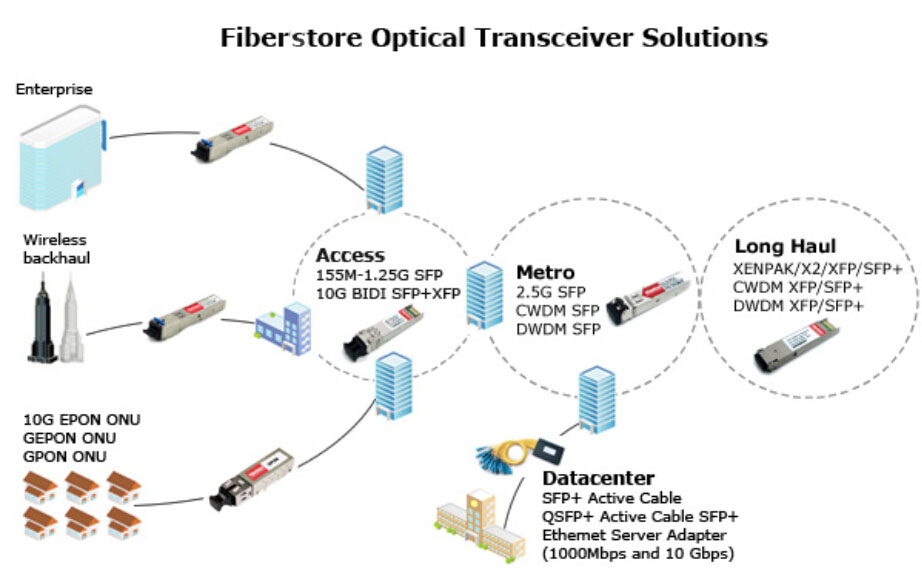
Application of Optical Transceiver Modules
Optical transceiver, essentially just completed the converted of data between different media, can realize the connection between two switches or computers in the 0-120km distance. Its main function is to achieve the conversion between optical-electrical and electrical-optical, including optical power control, modulation transmission, signal detection, IV conversion and limiting amplifier decision regeneration. In addition, there are some functions like security information query, TX-disable. Here is a summary in the practical application.
- Optical transceivers can interconnect with switches.
- Optical transceivers can interconnect between the switch and the computer.
- Optical transceivers can interconnect with computers.
- Optical transceivers can act as the transmission repeater.
When the actual transfer distance exceeds the nominal transmission distance of the transceiver, in particular, the actual transfer distance exceeds 120km alerts, with 2 sets transceiver back to back in the case of on-site conditions allow, repeaters or the use of "optical-optical" conversiona relay, is a very cost-effective solution. - Optical transceivers can offer conversion between single-mode and multimode fiber connection.
When the networks appear to need a single multimode fiber connection, you can use a multimode transceiver and a single-mode transceiver back-to-back connections, which can solve the problem of single multimode fiber converted. - Optical transceivers can offer WDM transmission.
The lack of resources of long-distance fiber optic cable, in order to improve the utilization rate of the fiber optic cable, and reduce the cost, transceiver and wavelength division multiplexer (WDM multiplexer) with the use of two-way information on the same fiber transmission.
Optical Transceiver modules can be classified according to the following aspects.
1. Optical Fiber Type
Single-mode fiber transceiver and Multimode fiber transceiver. The single-mode version has a transmission distance of 20 to 120 km, while the multimode one's is 2 to 5 km. Due to the different transmission distance, the transceivers' transmit power, receiver sensitivity and the use of wavelength will be different.
2. Optical Fiber Count
Simplex fiber transceiver and Duplex fiber transceiver. The simplex version receives the data sent in a single fiber transmission, While the duplex one receives data transmitted on a dual fiber transmission.By definition, single fiber devices can save half of the fiber, a fiber that is in the receive and transmit data, where the fiber is very applicable to resource constraints. These products use the wavelength division multiplexing techniques, mostly using the wavelength 1310nm and 1550nm.
3. Transmission Rate
Transmission rate refers to the number of gigabits transmitted per second, per unit of Mbps or Gbps. Optical modules cover the following main rate: low rates, Fast, Gigabit, 1.25G, 2.5G, 4.25G, 4.9G, 6G, 8G, 10G and 40G.
4. Package
SFP, SFP+, GBIC, XFP, XENPAK, X2, 1X9, SFF, 200/3000pin, XPAK, etc.
Fiberstore Optical Transceiver Solution
Fiberstore is a worldwide leading manufacturer & supplier of compatible fiber optical transceivers. We produce and stock for a full range of transceivers such as SFP Plus (SFP+), X2, XENPAK, XFP, SFP, GBIC. In the market, there are many brands of fiber optic transceiver, HP, Cisco, NETGEAR, Finisar, Dell, etc. The following table is the order information of HP SFP transceiver:
- SFP-1GT-1MA-HPHP, JD089B X120 compatible 1000BASE-T SFP Copper RJ45 100m
- SFP-1G85-5MA-HP, HP JD118B X120 compatible 1000BASE-SX SFP 850nm 550m DDM MMF
- SFP-1G31-10A-HP, HP JD119B X120 compatible 1000BASE-LX SFP 1310nm 10km SMF
- SFP-1G85-5ME-HP, HP J4858B X121 compatible 1000BASE-SX SFP 850nm 550m MMF
- SFP-1G85-5MF-HP, HP J4858C X121 compatible 1000BASE-SX SFP 850nm 550m MMF
- SFP-1GT-1MD-HP, HP J8177C X121 compatible 1000BASE-T SFP Copper RJ45 100m
- SFP-1G31-10F-HP, HP J4859C X121 compatible 1000BASE-LX SFP 1310nm 10km SFP SMF
- BLSFP-1G34-10-HP, HP J9143B X122 compatible 1000BASE 1310nmTX/1490nmRX BIDI SFP 10km SMF
Oznake: optical transceiver, HP SFP
| < | srpanj, 2015 | |||||
| P | U | S | Č | P | S | N |
| 1 | 2 | 3 | 4 | 5 | ||
| 6 | 7 | 8 | 9 | 10 | 11 | 12 |
| 13 | 14 | 15 | 16 | 17 | 18 | 19 |
| 20 | 21 | 22 | 23 | 24 | 25 | 26 |
| 27 | 28 | 29 | 30 | 31 | ||
Srpanj 2015 (1)
Lipanj 2015 (4)
Svibanj 2015 (3)
Travanj 2015 (13)
Ožujak 2015 (10)
Veljača 2015 (8)
Siječanj 2015 (9)
Prosinac 2014 (4)
Dnevnik.hr
Gol.hr
Zadovoljna.hr
Novaplus.hr
NovaTV.hr
DomaTV.hr
Mojamini.tv
About Me
Ima Blogger, Just Share Various Fiber Optic Telecom Network Topics, Information, News, Questions, Sources and Network Solutions.
